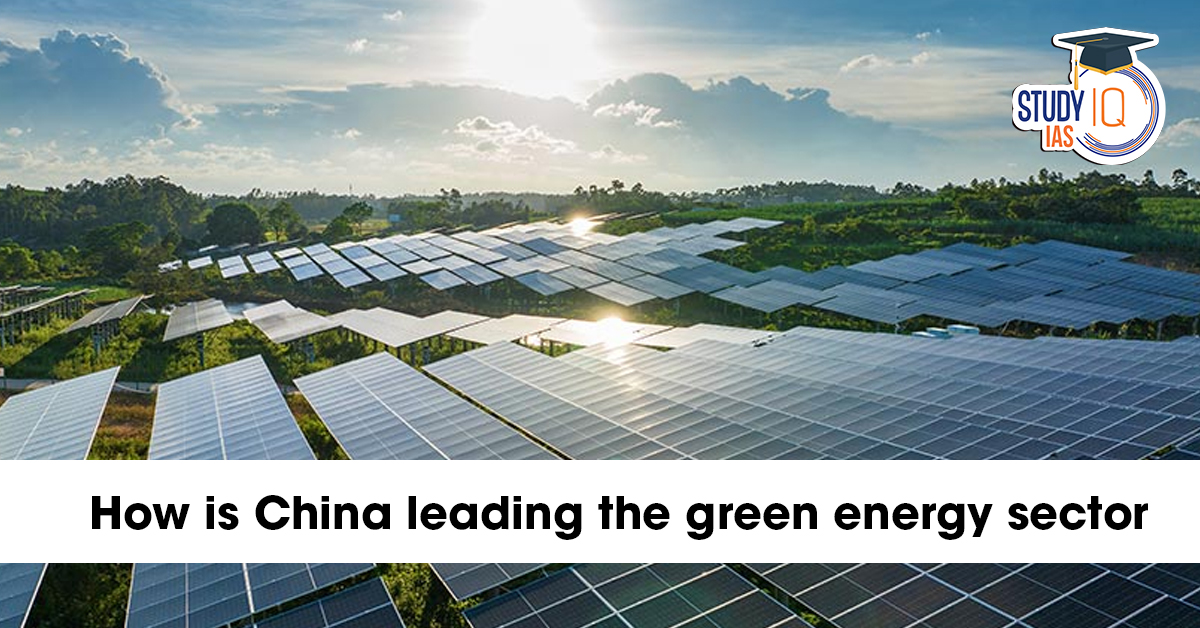Table of Contents
Context: China is leading the global green energy sector race.
Some Facts Related to China Leading the Green Energy Sector
- Installed More Than All Nations Combined (2024): In 2024, China installed more wind turbines and solar panels than every other country combined.
- $940 Billion Investment in 2024 Alone: China’s renewable sector saw a record investment of $940 billion, compared to $3.4 billion in India (2024–25).
- Supply Chain Control: Dominates manufacturing and supply chain in solar panels, wind turbines, and batteries, along with upstream raw materials like polysilicon and lithium.
- 55% of Global Renewable Energy Investment: Chinese State-Owned Enterprises (SOEs) account for 55% of all global green energy investments (Bloomberg).
China’s Journey to Green Energy Superpower
- Crisis as Catalyst: Severe air pollution and energy insecurity in the early 2000s sparked a green transition.
- Reliance on coal made major cities nearly unlivable, triggering public pressure.\
- Policy & Planning:
- Renewable Energy Law (2005): Guaranteed grid access and pricing incentives for renewables.
- 11th Five-Year Plan (2006–10): Made renewables a national priority.
- Provinces like Gansu, Inner Mongolia, and Jiangsu were used for pilot projects.\
- Role of SOEs and Banks: SOEs (State Grid, Huaneng, Genertec) executed mega projects.
- Public banks provided low-interest loans to scale renewables.
- R&D and Manufacturing Scale:
- Massive government subsidies and R&D investment reduced costs.
- Vertical integration enabled scale and global exports (e.g. Belt and Road Initiative).
- Infrastructure Investment:
- Overcame curtailment issues by investing in ultra-high-voltage transmission.
- State Grid’s investment doubled from $33.3 billion (2010) to $88.7 billion (2024).
Implications of China’s Green Energy Leadership
- Global Energy Power Shift: China has set the rules of the game by dominating not just manufacturing, but innovation and deployment too.
- It now exports energy infrastructure globally—61 countries engaged via BRI.
- Strategic Control: China’s control over critical materials (lithium, rare earths) and component production (solar wafers, batteries) makes many nations dependent on Chinese supply chains.
- Diplomacy & Statecraft Tool: Renewable technology has become part of China’s geopolitical toolkit, used to strengthen relations with Africa, Southeast Asia, and Latin America.
- Western Reaction: Countries like the U.S. are now trying to “reshore” green energy through acts like the Inflation Reduction Act, but face higher costs and slower deployment.
Key Lessons for India & the World
- Strategic Long-Term Planning Pays Off: China’s two-decade lead came from consistency in planning, starting from small pilot projects to national scaling.
- SOEs as Enablers: State-owned enterprises can drive rapid deployment when supported with mandates, capital, and policy alignment.
- Build Infrastructure Alongside Capacity: Curtailment problems in the mid-2010s show that generation without transmission infrastructure creates inefficiencies.
- Balance Speed with Oversight: Over-subsidisation led to wastage and overcapacity; later corrected by better planning and monitoring.
- Global Vision is Key: China’s export-oriented strategy and alignment with global markets (via BRI) helped it scale and influence globally.
- Integration of Innovation: Future-ready investments in AI-powered grids, green hydrogen, and nuclear tech (thorium reactors) show how China blends R&D with deployment.


 Bonnet Macaques: Habitat, Features, Beha...
Bonnet Macaques: Habitat, Features, Beha...
 Periyar Tiger Reserve, Map, Flora, Fauna...
Periyar Tiger Reserve, Map, Flora, Fauna...
 Project Cheetah in India, Objectives, Ch...
Project Cheetah in India, Objectives, Ch...

























